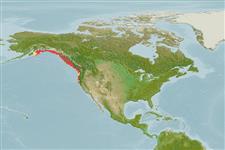Common names from other countries
>
Perciformes/Scorpaenoidei (Scorpionfishes) >
Sebastidae (Rockfishes, rockcods and thornyheads) > Sebastinae
Etymology: Sebastes: Greek, sebastes = august, venerable (Ref. 45335); emphaeus: From the Greek emphaeus, meaning 'display' (Ref. 27436).
More on author: Starks.
Environment: milieu / climate zone / depth range / distribution range
Écologie
marin récifal; profondeur 0 - 366 m (Ref. 27437). Temperate; 60°N - 38°N, 152°W - 120°W
Northeast Pacific: Kenai Peninsula, Alaska to northern California, USA.
Length at first maturity / Taille / Poids / Âge
Maturity: Lm 12.2 range ? - ? cm
Max length : 18.0 cm TL mâle / non sexé; (Ref. 2850)
Description synthétique
Morphologie | Morphométrie
Épines dorsales (Total): 13; Rayons mous dorsaux (Total): 14-15; Épines anales 3; Rayons mous anaux: 7. Head spines strong to moderate - nasal, preocular, postocular, tympanic and parietal spines present, supraocular, coronal and nuchal spines absent; anal fin rounded (Ref. 27437). Caudal fin weakly forked (Ref. 6885). Reddish brown to copper with dark blotches dorsally, fading to white, often with a dark stripe ventrally; red mouth; fins transparent, tinged with pink (Ref. 27437).
Inhabits reefs and rocky shorelines and found in loose congregations hovering above the bottom or resting among caves and crevices (Ref. 27436). Seeks shelter in areas of strong current (Ref. 2850). Viviparous (Ref. 34817). Flesh is tasty and flaky, but since it is rarely caught, it is seldom used as a food fish (Ref. 2850, 27436). May be used as bait for large rockfish, lingcod or cabezon (Ref. 27436).
Eschmeyer, W.N., E.S. Herald and H. Hammann, 1983. A field guide to Pacific coast fishes of North America. Boston (MA, USA): Houghton Mifflin Company. xii+336 p. (Ref. 2850)
Statut dans la liste rouge de l'IUCN (Ref. 130435)
CITES (Ref. 128078)
Not Evaluated
Menace pour l'homme
Harmless
Utilisations par l'homme
Aquarium: Aquariums publics; appât: occasionally
Plus d'informations
RéférencesAquacultureProfil d'aquacultureSouchesGénétiqueElectrophoresesHéritabilitéPathologiesTraitementMass conversion
CollaborateursImagesStamps, Coins Misc.SonsCiguateraVitesseType de nageSurface branchialeOtolithesCerveauxVision
Outils
Articles particuliers
Télécharger en XML
Sources Internet
Estimates based on models
Preferred temperature (Ref.
115969): 5.6 - 9.1, mean 6.9 (based on 125 cells).
Phylogenetic diversity index (Ref.
82804): PD
50 = 0.5000 [Uniqueness, from 0.5 = low to 2.0 = high].
Bayesian length-weight: a=0.01202 (0.00648 - 0.02231), b=3.09 (2.93 - 3.25), in cm Total Length, based on LWR estimates for this species & Genus-body shape (Ref.
93245).
Niveau trophique (Ref.
69278): 3.3 ±0.2 se; based on diet studies.
Résilience (Ref.
120179): Milieu, temps minimum de doublement de population : 1,4 à 4,4 années (K=0.54-0.70; tm=1.9; tmax=13; Fec=3,295).
Fishing Vulnerability (Ref.
59153): Low vulnerability (20 of 100).
